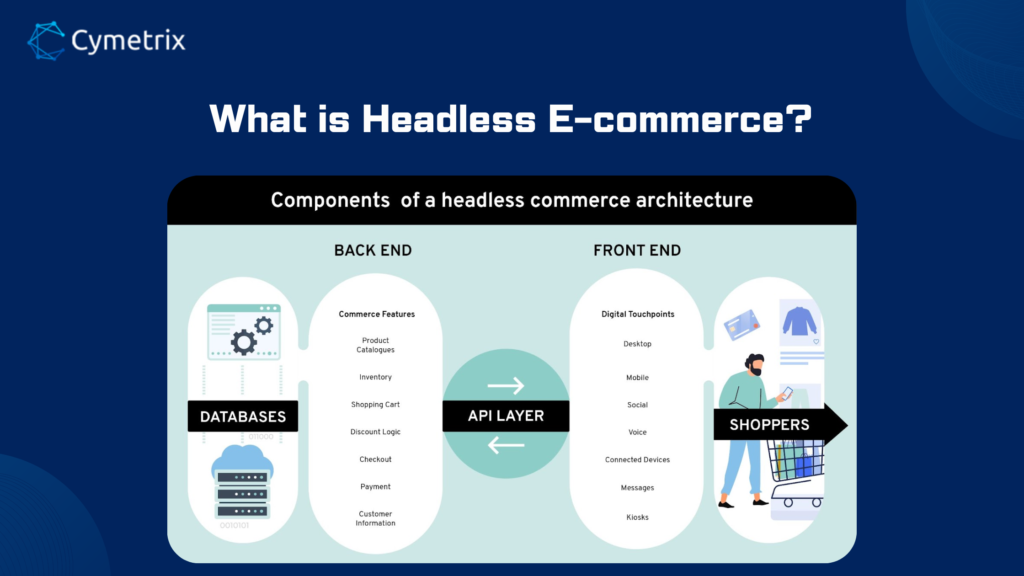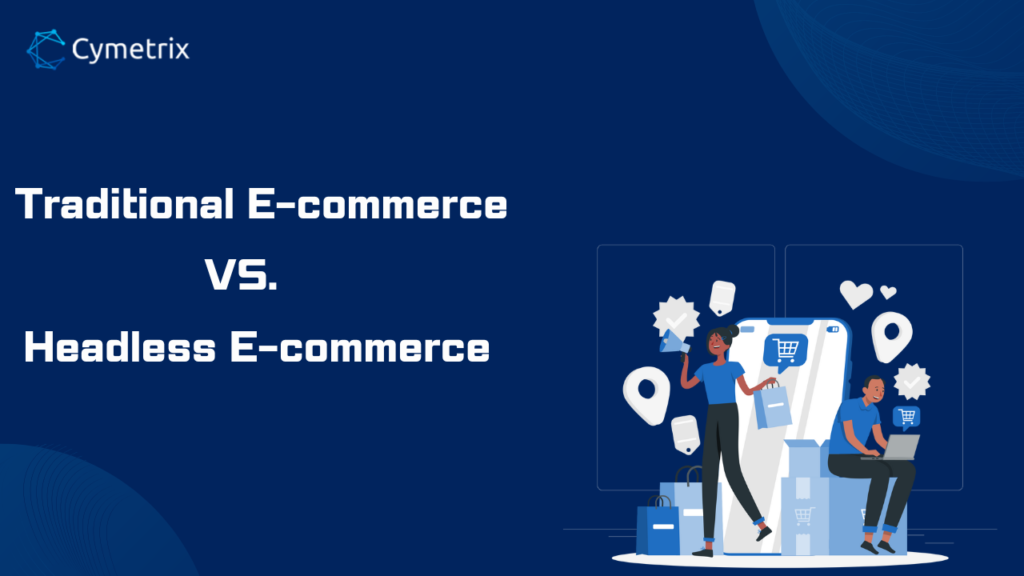
What is Headless Ecommerce? Discover the future of online shopping with Headless Ecommerce! Learn how this innovative approach decouples front-end and back-end, enabling seamless user experiences, faster loading times, and limitless customization. Stay ahead in the e-commerce game!
The world of e-commerce has undergone a remarkable transformation in recent years, fueled by advancements in technology and changing consumer demands. As a result, Headless Ecommerce has emerged as one of the prominent trends in the industry and is having a significant impact. But what exactly is headless e-commerce, and why is it causing such a buzz among online retailers and developers alike?
Cymetrix Software, one of the leading global Salesforce Implementation Partners, will help you understand more about Headless Commerce. So, keep reading to learn more.
What is Headless Ecommerce?
Headless e-commerce refers to separating the front-end and back-end of an online store. Unlike traditional e-commerce websites, where the front-end and back-end are tightly integrated, headless commerce decouples these two components, allowing businesses greater flexibility and control over their digital shopping experiences.
Primary Components of Headless Ecommerce
Now, to understand more about what is headless Ecommerce, it is essential to understand its primary components. Headless e-commerce comprises several essential components that work together to create a seamless and powerful online shopping experience. These key components include:
Content Management System (CMS)
A Content Management System (CMS) plays a pivotal role in headless e-commerce, empowering businesses to efficiently manage their content without being tied to the frontend presentation layer. The decoupled nature of a headless e-commerce CMS facilitates easy customization and personalization of content. Businesses can tailor content to specific audience segments, providing unique shopping experiences to different customer groups.
Application Programming Interfaces (APIs)
APIs serve as the communication bridge between the front end and back end. They facilitate data exchange and ensure seamless integration with various systems, such as inventory management, payment gateways, and customer relationship management (CRM) tools.
Front-end Technologies
Headless commerce empowers businesses to choose the front-end technologies that best suit their needs. This flexibility enables the creation of highly immersive and interactive shopping experiences across multiple devices and channels.

Headless Ecommerce Vs. Traditional E-Commerce
When we talk about building an online store, businesses have traditionally relied on the all-in-one approach of traditional e-commerce platforms. However, with the rise of headless e-commerce, it offers a fresh perspective and a different set of advantages. Let’s compare headless commerce with traditional e-commerce to understand their differences and benefits.
Architecture
Traditional e-commerce platforms follow a monolithic architecture, where the front-end and back-end are integrated closely. So, any changes or updates to the front end can affect the entire system.
However, the headless e-commerce platform adopts a decoupled architecture, separating the front-end and back-end. That allows for independent development and customization of both components, offering greater flexibility and scalability.
Flexibility and Customization
Traditional e-commerce platforms often come with pre-built templates and themes that limit the degree of customization. You are bound to the platform’s design choices and may face challenges when creating a unique and tailored user experience.
In contrast, headless commerce allows you to choose and implement any front-end technology you desire. This flexibility allows for highly customized and immersive shopping experiences that align with the brand’s identity and customer preferences.
User Experience
User experience plays a crucial role in the success of any online store. Traditional e-commerce platforms may provide a solid foundation for user interactions, but they sometimes lack the modern and interactive features that customers expect.
Headless e-commerce, with its decoupled architecture, opens the door to leveraging the latest technologies, such as Progressive Web Apps (PWAs), voice commerce, and augmented reality. These advancements enable businesses to deliver seamless and engaging user experiences across various touchpoints.
Scalability and Future-Proofing
As businesses grow and evolve, scalability becomes a critical factor. Traditional e-commerce platforms may have limitations for scaling up or adopting new technologies.
Whereas, a headless e-commerce platform offers inherent scalability and future-proofing capabilities. With the ability to integrate with various technologies through APIs, you can adapt and expand your online stores to meet changing customer demands and market trends.
Headless Ecommerce Examples and Use Cases
Headless e-commerce opens up a world of possibilities for businesses across various industries. Let’s explore some of the primary use cases and examples where headless architecture can make a significant impact:
Personalized User Experiences
Headless e-commerce allows businesses to create highly personalized and tailored user experiences. Whether it’s a Progressive Web App (PWA) for a seamless mobile experience or a voice commerce application for hands-free shopping, the headless architecture enables businesses to meet the unique needs and preferences of the targeted audience.
For instance, Burrow, a furniture company, wanted a template-free site to unleash unlimited creativity and offer customized experiences for its customers. As a result of switching to headless, Burrow witnessed a 30% increase in their site’s conversion rate within 2 months of implementing this change.
Omni-Channel Commerce
In today’s multi-channel world, businesses should provide a consistent and seamless experience across various touchpoints. Headless e-commerce enables the integration of multiple sales channels, such as websites, mobile apps, social media platforms, voice assistants, and even in-store displays.
For example, Nike used headless commerce to create a mobile-first eCommerce website to gain more sales from their mobile-dominant consumer segment.
Content-Driven Commerce
For businesses that heavily rely on content marketing and storytelling, headless e-commerce is a perfect opportunity. You can integrate a CMS with the headless architecture and deliver engaging content alongside your products or services. This combination enables storytelling and product showcasing, enriching the overall customer experience and driving higher engagement and conversions.
To illustrate, Frank Body wanted to create a fun and energetic aesthetic on its website that aligned with its copywriting style and overall branding. So, by adopting headless technology, they managed to transform the overall experience of their website. They used static images, and GIFs, along with a horizontal display front-end to deliver a unique experience.
Scalable Ecosystems
Furthermore, headless e-commerce provides the flexibility and scalability needed for businesses to grow and adapt to changing market dynamics. With a decoupled architecture, you can easily integrate new technologies, and scale your operations without disrupting the entire system. Whether you need to integrate third-party services or expand into emerging channels, headless architecture helps build scalable ecosystems that can evolve with your needs.
For example, Koala wanted a backend platform to support their business’s expansion. They used Headless Ecommerce to enhance their website’s response time by separating back-end functions away from the user. Thus, significantly decreasing slow interfaces and negative customer experiences.
Internationalization and Localization
For businesses operating in global markets, headless e-commerce offers significant advantages in terms of internationalization and localization. With the ability to manage multiple front-end experiences through a single back-end, businesses can efficiently tailor their offerings to different regions, languages, and cultural preferences. As a result, localization capability enables you to provide a more personalized and relevant experience to international customers.
Salesforce for Headless Ecommerce
Salesforce Commerce Cloud is a leading platform that enables headless e-commerce for businesses of all sizes and industries. It offers a flexible, and scalable solution that combines powerful commerce APIs, AI-powered personalization, a Progressive Web App (PWA) storefront, and a proven partner ecosystem to help businesses build and run headless e-commerce experiences faster and with lower total cost of ownership.
Some of the benefits of using Salesforce Headless Commerce Cloud are:
- Freedom of expression: Businesses can create unique and immersive shopping experiences that blend commerce, content, and personalization seamlessly through APIs, without being restricted by templates or predefined layouts.
- New revenue channels: You can reach new customers and markets by inserting commerce functionality into any touchpoint, such as Instagram, Facebook, video games, and more, using an API-first approach.
- Speed and agility: Headless in Commerce Cloud can help deploy changes quickly and frequently, with minimal risk and rollback windows, using modern infrastructure and developer tools that boost productivity and efficiency.
- Connected customer data: It can help provide a complete view of their customers across marketing, sales, service, and more on the Salesforce Customer 360 platform, which connects commerce data with other data sources to enable personalized and consistent experiences across the customer journey.
Conclusion
In the rapidly changing world of e-commerce, where competition is fierce, businesses need to be proactive. To stay ahead, consider implementing headless e-commerce, a cutting-edge approach that provides the freedom to customize and optimize user experiences for maximum impact.
Take the next step in transforming your online store with Cymetrix Software and Salesforce Commerce Cloud. So, get in touch with us to explore how Salesforce Commerce Cloud and headless e-commerce can revolutionize your online business.
